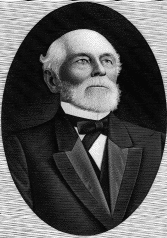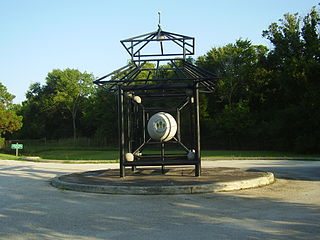
William Marsh Rice was an American businessman who bequeathed his fortune to found Rice University in Houston, Texas.

A swamp is a wetland that is forested. Many swamps occur along large rivers where they are critically dependent upon natural water level fluctuations. Other swamps occur on the shores of large lakes. Some swamps have hammocks, or dry-land protrusions, covered by aquatic vegetation, or vegetation that tolerates periodic inundation or soil saturation. The two main types of swamp are "true" or swamp forests and "transitional" or shrub swamps. In the boreal regions of Canada, the word swamp is colloquially used for what is more correctly termed a bog, fen, or muskeg. The water of a swamp may be fresh water, brackish water or seawater. Some of the world's largest swamps are found along major rivers such as the Amazon, the Mississippi, and the Congo.

A marsh is a wetland that is dominated by herbaceous rather than woody plant species. Marshes can often be found at the edges of lakes and streams, where they form a transition between the aquatic and terrestrial ecosystems. They are often dominated by grasses, rushes or reeds. If woody plants are present they tend to be low-growing shrubs. This form of vegetation is what differentiates marshes from other types of wetland such as swamps, which are dominated by trees, and mires, which are wetlands that have accumulated deposits of acidic peat.
Richard Walter Quick was the head coach of the women's swim team at Stanford University, from 1988 through 2005. He was a coach for the United States Olympic swimming team for six Olympics—1984, 1988, 1992, 1996, 2000 and 2004. Following the 2007 season, he returned to Auburn University as head coach of the men's and women's swimming and diving team.
Michael Lawrence Marsh is a retired American sprinter, the 1992 Olympic champion in the 200 m.

Matagorda Bay is a large Gulf of Mexico estuary bay on the Texas coast, lying in Calhoun and Matagorda counties and located approximately 80 miles (130 km) northeast of Corpus Christi, 143 miles (230 km) east-southeast of San Antonio, 108 miles (174 km) south-southwest of Houston, and 167 miles (269 km) south-southeast of Austin. It is separated from the Gulf of Mexico by Matagorda Peninsula and serves as the mouth of numerous streams, most notably the Lavaca and Colorado Rivers. The Texas seaport of Port Lavaca is located on the system's northwestern extension of Lavaca Bay. The city of Palacios is found on northeastern extension of Tres Palacios Bay, and Port O'Connor is located on the southwestern tip of the main bay's shore. The ghost town of Indianola, which was a major port before it was destroyed by two hurricanes in the late 19th Century, is also found on the bay.

Sea Rim State Park is a 4,141-acre (1,676 ha) state park in southeast Texas. The park is located on the Gulf of Mexico in southern Jefferson County, south of Port Arthur and just west of Sabine Pass. The park was closed for several years due to extensive damage from Hurricanes Rita (2005) and Ike (2008). The park has recently re-opened but currently has limited resources.

The Beaumont Enterprise is a newspaper of Hearst Communications, headquartered in Beaumont, Texas. It has been in operation since 1880.
Stanley Marsh 3, was an American artist, businessman, philanthropist, and prankster from Amarillo, Texas. He is perhaps best known for having been the sponsor of the Cadillac Ranch, an unusual public art exhibit off historic Route 66, now Interstate 40, west of Amarillo. He was born in Amarillo in 1938.

Oryzomys couesi, also known as Coues' rice rat, is a semiaquatic rodent in the family Cricetidae occurring from southernmost Texas through Mexico and Central America into northwestern Colombia. It is usually found in wet habitats, such as marshes, but also lives in drier forests and shrublands. Weighing about 43 to 82 g, O. couesi is a medium-sized to large rat. The coarse fur is buff to reddish above and white to buff below. The hindfeet show some specializations for life in the water, such as reduced ungual tufts of hair around the digits. It has 56 chromosomes. There is much geographic variation in size, proportions, color, and skull features. Oryzomys couesi is active during the night and builds nests of vegetation that are suspended among reeds about 1 m (3.3 ft) above the ground. It is an excellent swimmer and dives well, but can also climb in vegetation. An omnivore, it eats both plant and animal food, including seeds and insects. It breeds throughout the year; females give birth to about four young after a pregnancy of 21 to 28 days. The species may be infected by several different parasites and by two hantaviruses.

KVII-TV, virtual and VHF digital channel 7, is an ABC-affiliated television station licensed to Amarillo, Texas, United States. The station is owned by the Sinclair Broadcast Group. KVII's studios are located at One Broadcast Center between South Pierce and South Buchanan Streets – in downtown Amarillo, and its transmitter is located on Reclamation Plant Road in unincorporated Potter County. On cable, the station is available on Suddenlink Communications channel 8 in standard definition and digital channel 708 in high definition in Amarillo, and on channel 7 on other providers in outlying areas of the market.

Iva is a genus of wind-pollinated plants in the daisy family, described as a genus by Linnaeus in 1753. Plants of this genus are known generally as marsh elders. The genus is native to North America.
- Iva angustifolia - southeastern + south-central United States
- Iva annua - United States, primarily south-central region; Tamaulipas
- Iva asperifolia - south-central United States, Veracruz
- Iva axillaris - western United States + Canada
- Iva cheiranthifolia - Cuba
- Iva ciliata - south-central United States
- Iva corbiniiB.L. Turner - Texas
- Iva dealbata - United States, Mexico
- Iva frutescens - coastal areas from Texas to Nova Scotia
- Iva hayesiana - California, Baja California
- Iva imbricata - coastal areas from Texas to Virginia; Bahamas
- Iva microcephala - southeastern United States
- Iva xanthiifolia - widespread in United States + Canada, introduced elsewhere

The marsh rice rat is a semiaquatic North American rodent in the family Cricetidae. It usually occurs in wetland habitats, such as swamps and salt marshes. It is found mostly in the eastern and southern United States, from New Jersey and Kansas south to Florida and northeasternmost Tamaulipas, Mexico; its range previously extended further west and north, where it may have been a commensal in corn-cultivating communities. Weighing about 40 to 80 g, the marsh rice rat is a medium-sized rodent that resembles the common black and brown rat. The upperparts are generally gray-brown, but are reddish in many Florida populations. The feet show several specializations for life in the water. The skull is large and flattened, and is short at the front.

Armand Bayou Nature Center is an urban preserve located in Pasadena and southeast Houston between the Johnson Space Center and the Bayport Industrial District. The 2,500-acre (10 km2) nature center is the largest urban wilderness preserve in the United States.

The Baytown Nature Center is located in Baytown, Texas, 20 miles (32 km) east of Houston. It is located on a 450-acre (1.8 km2) peninsula along the Houston Ship Channel and surrounded on three sides by Burnet Bay, Crystal Bay, and Scott Bay.

The Great Texas Coastal Birding Trail is a state-designated system of trails, bird sanctuaries, and nature preserves along the entire length of the Texas Gulf Coast in the United States. As the state of Texas hosts more bird species than any other in the U.S. the trail system offers some of the most unusual opportunities for bird-watching in the world. The "trail" is actually 43 separate hiking and driving trails that include 308 birding sites. The sites themselves feature a variety of viewing opportunities with boardwalks, observation decks, and other amenities. The trails boast more than 450 bird species. The trail system is managed by the Texas Parks and Wildlife Department as part of the Great Texas Wildlife Trails which also include the Heart of Texas Wildlife Trail, the Panhandle Plains Wildlife Trail, and the Prairies and Pineywoods Wildlife Trail.

Pine Gully Park is a 52-acre (21 ha) park located in Seabrook, Texas in the United States, near Houston. It is located on the shore of Galveston Bay. The park belongs to the Seabrook Trail System and includes undeveloped and restored woodlands, salt marshes and several species of wildlife.
Tanner Marsh is a professional American football quarterback who is currently a free agent.

Tyrrell Park is a municipal park located in Beaumont, Texas. The park has an area of around 500 acres (2.0 km2). It includes the eighteen hole Henry Homberg Golf Course; the Beaumont Botanical Gardens and Warren Loose Conservatory, the second largest public conservatory in Texas; a hiking trail; an equestrian center; and facilities for several sports and outdoor activities. Adjacent to the park is the 900 acres (4 km2) Cattail Marsh, a nature center with hiking trail. The park is located in a migratory bird flyway and Tyrrell Park is listed on the Great Texas Coastal Birding Trail.




















